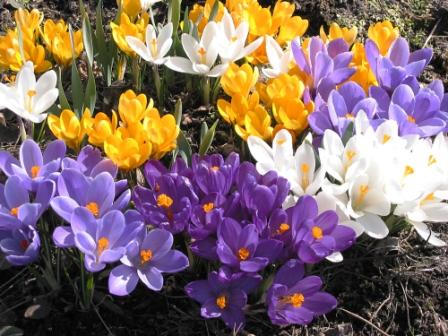Bulbs, Making the Right Choice
By Jos Van Hage

It’s that time of year again!
The fall planted bulbs are in and once planted will bloom next spring. The more common fall bulbs include daffodils, crocus, tulips, snowdrops, allium, hyacinth, fritillaria,
scillia, and muscari. Bulbs are a great investement for the garden because they will bloom for years to come if they are given the right care and conditions.
When choosing varieties of fall bulbs always choose varieties and types that are hardy enough to withstand our zone 3 climate, as they stay in the ground throughout the year. When picking out bulbs, always pick bulbs that are firm, with no scars, or blemishes and are clean of any disease or fungus.
It is also good to remember that size counts when picking out bulbs. The bigger the bulb the bigger the flower will be, because the bulb is the storehouse for the flower and nutrients, so it only makes sense that the biggest bulbs will have the biggest flowers.
When it comes to planting your bulbs you want to plant them as early as possible so that the bulb can get a good root system started before winter sets in. Plant the bulb in a well drained soil so that the bulb does not rot. If your soil is not well drained add some sandy loam to the soil.
Always plant bulbs in groups of 7-9 for the best affect, so dig a hole large enough to hold a group of bulbs with a space of 2-3 inches between the smaller sized bulbs and 5-6 inches for the larger sized bulbs. The depth of the hole depends on the bulb you are planting but a rule of thumb is plant the bulb at a depth that is twice the height of the bulb. Before you place the bulb in the hole, mix some bonemeal with the soil in the bottom of the hole before placing the bulbs in the hole with the pointed end up. Cover the
bulbs with the remaining soil and water them in well. It is important to keep the bulbs watered until the frost sets in for the winter so if the weather becomes dry or you are planting under an overhang or eave give the bulbs a regular water.
When choosing a site to plant your bulbs you should know how tall the bulbs will be and when the bloom time is. This way you can plant around perennials and other bulbs. Planting behind perennials is a good way to hide the dying foliage of the bulb after it has finished blooming. It is important to remove the seed pod from the flower after it
has finished blooming and then allow the foliage to die back naturally as this is the time when the bulb is forming next years flower. If you remove the foliage before allowing it to die back naturally there will be no flower next spring.
Bulbs do not require a lot of maintenance, however, every few years when you see that the flowers are becoming smaller they should be dug up and divided. This is done in late July or early August after the foliage has died back. Dig up the bulbs and let them air dry for a couple of weeks, then separate the bulbils (small bulbs attached to the large main bulb). The bulbils can either be stored along with the big bulbs are thrown out. If you plan on storing the bulbils and replanting them, do not expect any flowers
from them for the first couple of years until the bulbils have grown in size.
To store the bulbs until you replant them again in September, you should sprinkle them with ’Bulb Dust’ a fungicide/insecticide and then store them in a dry place until they are replanted.
-Jos
Jos Van Hage owns and operates two Art Knapp Garden Centres in the Prince George area:
- Highway 16 West at Kimball Road
- Highway 97 North at Northwood Pulpmill Road
Previous Story - Next Story
Return to Home










